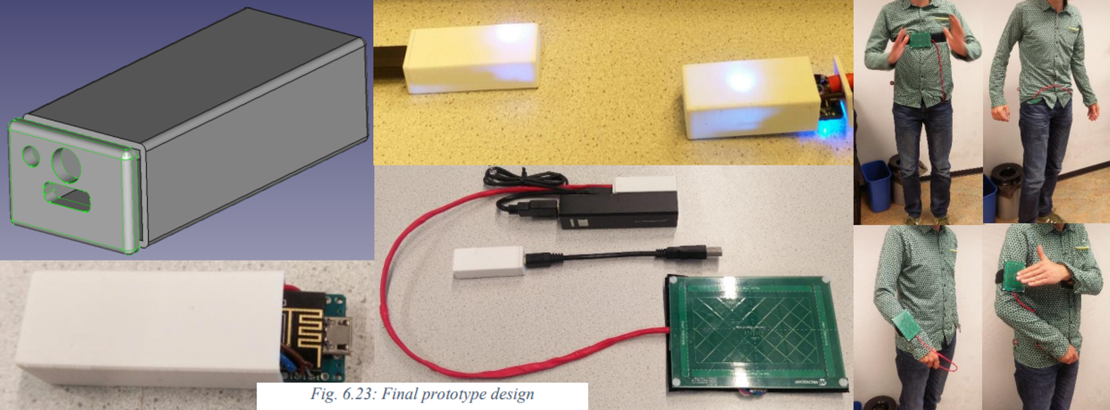"I add intelligence to everyday devices, so they contribute to energy transition"
Interview with Jules van Dijk by Diana Dalenoord
Why Creative Technology?
I found the broad approach of the Bachelor’s in Creative Technology very appealing. After graduating from VWO, I had many interests, which made it difficult to choose a programme. New smart technologies, gadgets and applications inspired me enormously, such as Homey, a smart home device, which was developed by 2 CreaTe students. The idea behind creating different smart devices fascinated me. So, CreaTe was right up my alley.
What did you learn in Creative Technology?
During my Bachelor’s I learned about different kinds of development processes and how to develop things quickly. From ideas to solutions, starting from the first concept, and then going to the testing rounds to see if your idea works and whether you solved your customer's problem. We also worked on adding intelligence to existing devices, such as a smart coffee mug. It tracks and notifies you on your caffeine intake, hydration and activity. So basically, your mug keeps an eye on your health. Working on this kind of Smart Technology is fun!
Engineering knowledge is very valuable. You learn about pulses in motors, voltages, how resistors work, how to display data on screens, implement hardware and you practice with various computer programs. I still use this knowledge and the mindset to make devices smarter in my work at TotalEnergies.
Wearables
I did my undergraduate assignment under the supervision of Edwin Dertien. The assignment I was given was "Create a wearable and provide a toolbox for CreaTe students for three-dimensional motion sensors to achieve a particular task.

I developed a presentation tool, a wireless presentation remote that you could wear under your clothes, which was controlled via motion sensors. By swiping your hand in the air, you controlled your presentation. To develop this, I used electrical engineering knowledge, programming, and I worked a lot in the RAM (Robotics and Mechatronics) Lab. I used this invisible presentation remote during my undergraduate assignment presentation. Of course, it was very exciting to see if it would work, which it did!
A life after CreaTe
During my minor, I did the Pre-master’s in Sustainable Energy Technology (SET). I found CreaTe to be a very interesting programme. Because of my interest in sustainable energy, I pivoted to the Master’s in SET. With my CreaTe background, this was definitely a good choice as I combined my background on smart devices, electrical engineering and programming from CreaTe, with my gained knowledge in the energy system to specialize in Distributed Energy Management Systems, which use smart devices to balance the energy system and accelerate the energy transition. Best of both worlds.
Electrical cars
As an E-Mobility & Energy Analyst at TotalEnergies, I develop algorithms for smart charging of electric cars. In residential areas, when people come home in the evening, everyone turns on the lights and TV, cooks with electric appliances, and, more importantly, plugs in their electric vehicle, so power consumption increases drastically. If 10 million cars in the Netherlands would do that, the electrical grid would not be able to handle it. To avoid these fluctuations, you can delay your charging to later in the night. Like your phone, it doesn’t matter when it charges, as long as it is full when you wake up. You can even use the power stored on your car battery in the evening – during peak consumption- to power your electrical devices in your home, such as charging your laptop. At night - when there is less demand for power - you charge the car battery again. The car batteries thus work as a power buffer.
The new smart devices controlled by smart home systems can also be used to regulate energy consumption. Via the internet, you can remotely control your thermostat or smart washing machine. This way, you can balance energy consumption and ensure that there is always enough energy to prevent power outages. In short, you can take advantage of hidden technology, which allows smart devices to determine when to charge (i.e. in the evening or at night). This is a core part of the energy transition taught within SET, and it's also very CreaTe.
What are your future plans?
I really enjoy my work at TotalEnergies. In my work with electric vehicles, but I've also taken on the role of internship supervisor. It's exciting to transfer your experiences and knowledge to someone who is just entering the world of the energy transition.
Name: Jules van Dijk - to be contacted via jules.van-dijk@totalenergies.com
Bachelor’s: Creative Technology at University of Twente, Netherlands
Master’s: Sustainable Energy Technology at University of Twente, Netherlands
Work: E-Mobility & Energy Analyst at TotalEnergies, Den Haag, Netherlands
 TotalEnergies offers opportunities for internships, contact person Jules van Dijk, or check the website https://www.utwente.nl/en/eemcs/energy/assignments/available%20assignments/total-energies-artificial-intelligence-for-ev/
TotalEnergies offers opportunities for internships, contact person Jules van Dijk, or check the website https://www.utwente.nl/en/eemcs/energy/assignments/available%20assignments/total-energies-artificial-intelligence-for-ev/
